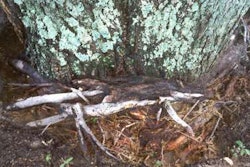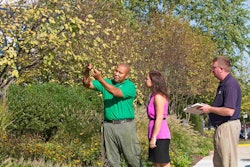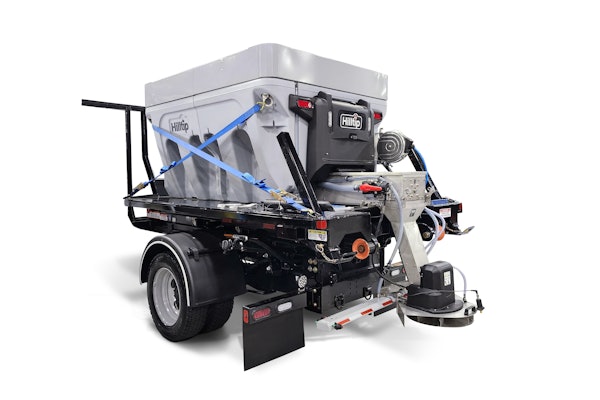 Fieldstone fireplace with raised bluestone hearth becomes an attractive focal point in the yard.
Fieldstone fireplace with raised bluestone hearth becomes an attractive focal point in the yard. Photo: Heidi Miscovic, Borst Landscape and Design
No matter where you live, there’s something peaceful about sitting by the fire. Firepits and fireplaces add a soothing ambiance, provide warmth on cool evenings, extend the season and offer a cozy backdrop to dining al fresco. And they’ve never been more popular.
Most landscape professionals have seen demand rise quickly over the years, even for modestly sized outdoor living spaces. “Everyone used to ask for water features, but now it’s firepits and fireplaces,” says Dave Beasley, designer with Borst Landscape and Design in Allendale, New Jersey. “They’re appealing because they create a gathering spot, and they require almost no maintenance.”
Fire features often are requested as part of a larger project such as an outdoor kitchen or new patio. But their low maintenance means they’re a potential upsell for other outdoor living spaces you’re already bidding. Typically, you’ll see profit margins of 30 percent or more.
Here’s what to consider when adding this landscape element to your designs:
Decide on firepit vs. fireplace
Choosing between them is primarily a matter of personal taste. “Firepits are more casual and less costly, but they don’t have a strong vertical design element, and there’s no way to control the smoke,” says Josh Kane, president and head designer of Kane Landscapes in Potomac Falls, Virginia. “Fireplaces can be a focal point in the landscape and feel more formal and romantic. But they also use a lot of space, and you can only sit on one side.”
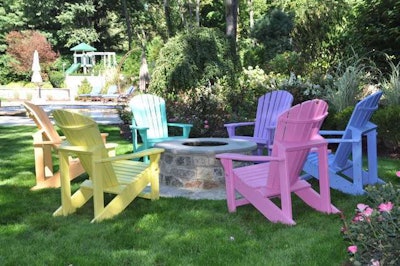 A natural stone veneer firepit with a bluestone cap provides a cozy gathering spot.
A natural stone veneer firepit with a bluestone cap provides a cozy gathering spot. Photo: Heidi Miscovic, Borst Landscape and Design
Either type of fire feature can be fueled by wood or gas. Some clients prefer the crackle and smell of a wood fire, while others like the no-mess convenience of natural gas or propane. For ease of lighting, most include an electric ignition or a gas starter for wood burners. Neither firepits nor fireplaces require winterization except for covering gas burners to protect them from the elements.
Custom firepits usually run from $2,500 to $5,000. Custom fireplaces start at about $12,000 and often reach $30,000 or more, with the cost increasing with add-ons such as wing walls and mantel pieces. Prefabricated kits, which are relatively simple to install, can reduce the price by about a third. Typical construction materials include synthetic veneers, stucco, brick, slate or concrete with firebrick interiors. Natural stone is not preferred for wood firepits, Beasley says, as some types, such as sandstone, may crack under high heat conditions.
Know local laws
Firepits and fireplaces must comply with national and local fire codes, which usually require that firepits and outdoor fireplaces be at least 15 feet from a structure such as the house, garage, shed or fence. Local ordinances also may limit fireplace size and chimney height, says Beasley. Typically, permits must be pulled and inspections fulfilled for electrical and plumbing. In some municipalities, outdoor fireplaces are considered an accessory-use building and must comply with all local building codes.
Find the best location
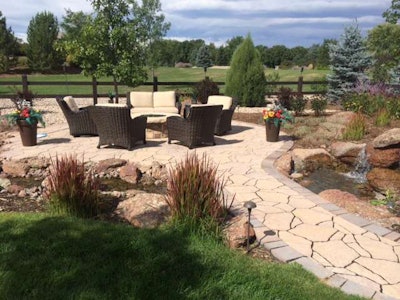 This firepit ties together multiple landscape elements for a cohesive design.
This firepit ties together multiple landscape elements for a cohesive design. Photo: Colorado Landscapes Unlimited
During the initial consultation, walk the property and look at the overall layout of the living space. Firepits won’t obstruct a view; fireplaces sometimes provide the view. “Choose a spot that’s not too far away from the house. You don’t want it too distant so clients never use it,” says Beasley. “It’s also nice to place it where you can see it from inside the house, especially if it’s a beautiful focal point.”
Examine traffic flow; you shouldn’t have to walk all the way around a fire feature every time you’re headed for the grill or pool. Ask how many people the clients want to accommodate. Will only family be gathering here or do they like to entertain? Leave plenty of room for furniture – Beasley suggests space for at least four Adirondack chairs.
Don’t forget to identify the location of utilities; it can be costly to place the fire feature somewhere that’s inconvenient to the gas line.
Make your design functional
Firepits and fireplaces tie in various design elements such as an outdoor kitchen and pool, or they can be used in a more practical manner. “We might use a fireplace as a wind block or a way to add privacy to a patio or to screen out a view,” says R.J. Morris, owner of Colorado Landscapes Unlimited in Fort Collins. “In this case, fireplaces become a sort of functional room.”
When working with other landscape elements, including surrounding plant materials, keep everything proportional. “You don’t want a fireplace that towers over every other element,” says Morris. On the other hand, make sure the height of the fire inside a firepit is slightly elevated so it doesn’t look like you’re burning something in the bottom of a barrel.
Finish off the space with little extras such as capstones that serve as additional seating or seat walls. Add a TV over the fireplace for sports fans. Include a removable cooking grate for firepits. If you’re adding wood boxes, place them on the back or slightly away from the firepit or fireplace – in an alcove behind a shed, for example. Obviously, you don’t want clients hauling it a long distance, but wood can attract pests so keep it away from seating areas.

